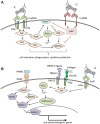How Autoantibodies Regulate Osteoclast Induced Bone Loss in Rheumatoid Arthritis
- PMID: 31333647
- PMCID: PMC6619397
- DOI: 10.3389/fimmu.2019.01483
How Autoantibodies Regulate Osteoclast Induced Bone Loss in Rheumatoid Arthritis
Abstract
Rheumatoid arthritis (RA) is a chronic inflammatory disease, characterized by autoimmunity that triggers joint inflammation and tissue destruction. Traditional concepts of RA pathogenesis have strongly been focused on inflammation. However, more recent evidence suggests that autoimmunity per se modulates the disease and in particular bone destruction during the course of RA. RA-associated bone loss is caused by increased osteoclast differentiation and activity leading to rapid bone resorption. Autoimmunity in RA is based on autoantibodies such as rheumatoid factor (RF) and autoantibodies against citrullinated proteins (ACPA). These autoantibodies exert effector functions on immune cells and on bone resorbing osteoclasts, thereby facilitating bone loss. This review summarizes potential pathways involved in increased destruction of bone tissue in RA, particularly focusing on the direct and indirect actions of autoantibodies on osteoclast generation and function.
Keywords: autoantibodies against citrullinated proteins (ACPA); cytokines; osteoclasts; rheumatoid arthritis; rheumatoid factor (RF).
Figures



References
Publication types
MeSH terms
Substances
Grants and funding
LinkOut - more resources
Full Text Sources
Medical

